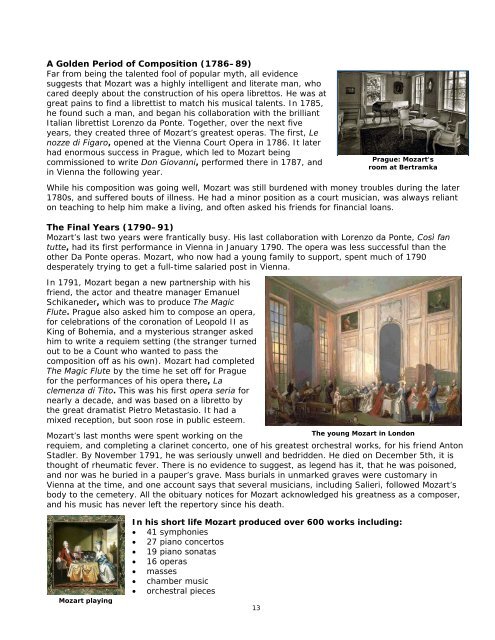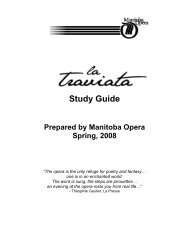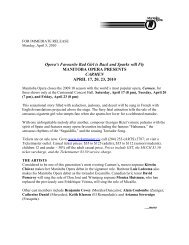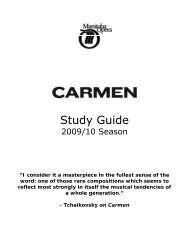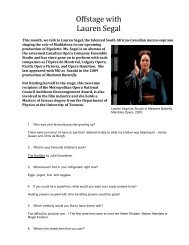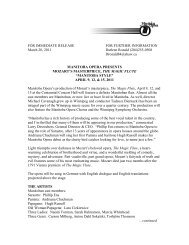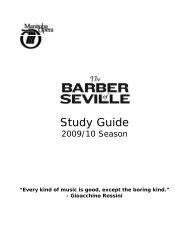The Magic Flute Study Guide - Manitoba Opera
The Magic Flute Study Guide - Manitoba Opera
The Magic Flute Study Guide - Manitoba Opera
Create successful ePaper yourself
Turn your PDF publications into a flip-book with our unique Google optimized e-Paper software.
A Golden Period of Composition (1786–89)<br />
Far from being the talented fool of popular myth, all evidence<br />
suggests that Mozart was a highly intelligent and literate man, who<br />
cared deeply about the construction of his opera librettos. He was at<br />
great pains to find a librettist to match his musical talents. In 1785,<br />
he found such a man, and began his collaboration with the brilliant<br />
Italian librettist Lorenzo da Ponte. Together, over the next five<br />
years, they created three of Mozart’s greatest operas. <strong>The</strong> first, Le<br />
nozze di Figaro, opened at the Vienna Court <strong>Opera</strong> in 1786. It later<br />
had enormous success in Prague, which led to Mozart being<br />
commissioned to write Don Giovanni, performed there in 1787, and<br />
in Vienna the following year.<br />
While his composition was going well, Mozart was still burdened with money troubles during the later<br />
1780s, and suffered bouts of illness. He had a minor position as a court musician, was always reliant<br />
on teaching to help him make a living, and often asked his friends for financial loans.<br />
<strong>The</strong> Final Years (1790–91)<br />
Mozart’s last two years were frantically busy. His last collaboration with Lorenzo da Ponte, Così fan<br />
tutte, had its first performance in Vienna in January 1790. <strong>The</strong> opera was less successful than the<br />
other Da Ponte operas. Mozart, who now had a young family to support, spent much of 1790<br />
desperately trying to get a full-time salaried post in Vienna.<br />
In 1791, Mozart began a new partnership with his<br />
friend, the actor and theatre manager Emanuel<br />
Schikaneder, which was to produce <strong>The</strong> <strong>Magic</strong><br />
<strong>Flute</strong>. Prague also asked him to compose an opera,<br />
for celebrations of the coronation of Leopold II as<br />
King of Bohemia, and a mysterious stranger asked<br />
him to write a requiem setting (the stranger turned<br />
out to be a Count who wanted to pass the<br />
composition off as his own). Mozart had completed<br />
<strong>The</strong> <strong>Magic</strong> <strong>Flute</strong> by the time he set off for Prague<br />
for the performances of his opera there, La<br />
clemenza di Tito. This was his first opera seria for<br />
nearly a decade, and was based on a libretto by<br />
the great dramatist Pietro Metastasio. It had a<br />
mixed reception, but soon rose in public esteem.<br />
Mozart’s last months were spent working on the<br />
requiem, and completing a clarinet concerto, one of his greatest orchestral works, for his friend Anton<br />
Stadler. By November 1791, he was seriously unwell and bedridden. He died on December 5th, it is<br />
thought of rheumatic fever. <strong>The</strong>re is no evidence to suggest, as legend has it, that he was poisoned,<br />
and nor was he buried in a pauper’s grave. Mass burials in unmarked graves were customary in<br />
Vienna at the time, and one account says that several musicians, including Salieri, followed Mozart’s<br />
body to the cemetery. All the obituary notices for Mozart acknowledged his greatness as a composer,<br />
and his music has never left the repertory since his death.<br />
Mozart playing<br />
In his short life Mozart produced over 600 works including:<br />
� 41 symphonies<br />
� 27 piano concertos<br />
� 19 piano sonatas<br />
� 16 operas<br />
� masses<br />
� chamber music<br />
� orchestral pieces<br />
13<br />
Prague: Mozart's<br />
room at Bertramka<br />
<strong>The</strong> young Mozart in London


